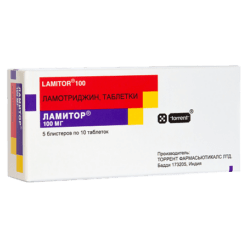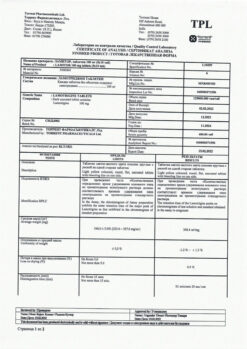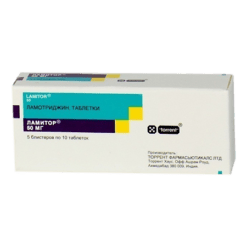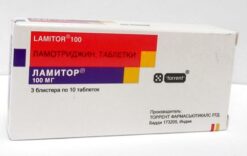No products in the cart.
Lamitor, tablets 25 mg 30 pcs
€1.00
Out of stock
(E-mail when Stock is available)
Description
Lamitor is an anticonvulsant (antiepileptic) drug.
A blocker of potential-dependent sodium channels.
Causes block of impulse discharges in neuronal culture and inhibits excessive release of glutamate (amino acids that play a key role in the generation of epileptic seizures) along with inhibition of glutamate-induced effector impulses.
Indications
Indications
For adults and children over 12 years old:
simple and complex partial convulsive seizures;
primary and secondary generalized tonic-clonic seizures;
absence seizures, typical and atypical;
myoclonic seizures;
seizures resistant to other antiepileptic drugs of any type.
For children aged 2 to 12 years – as an auxiliary therapy.
Pharmacological effect
Pharmacological effect
Lamitor is an anticonvulsant (antiepileptic) drug.
Voltage-gated sodium channel blocker.
Causes a block of impulse discharges in cultured neurons and inhibits excessive release of glutamate (amino acids that play a key role in the generation of epileptic seizures) along with inhibition of glutamate-induced effector impulses.
Special instructions
Special instructions
Information on the use of Lamitor in elderly patients is limited. Therefore, caution should be exercised when prescribing the drug to this category of patients.
If the dose of Lamitor is exceeded, skin rash may develop (in this situation, the drug should be discontinued).
In some cases, when prescribing the drug, severe skin rash (including Stevens-Johnson syndrome) may develop. Such reactions often develop in children. Lamitor should be discontinued at the first sign of a rash. The risk of developing such complications increases when Lamitor is prescribed concomitantly with sodium valproate and if the dose of Lamitor used exceeds the recommended initial and maximum daily dose.
If a skin rash develops, use of the drug should be stopped immediately.
When using Lamitor, it is possible to develop such hypersensitivity symptoms (in some cases, even death) such as fever, malaise, cold symptoms, drowsiness, lymphadenopathy, facial swelling and, in very rare cases, liver dysfunction, hematopoietic disorders (leukopenia and thrombocytopenia). In most patients, these symptoms disappear after stopping Lamitor.
If rash, chills, cold symptoms, drowsiness, or worsening seizure control (especially during the first month) occur while using the drug, liver function tests, kidney function tests, and blood clotting should be monitored.
If Lamitor is abruptly discontinued, seizures may become more frequent. The dose of Lamitor should be reduced gradually over 2 weeks.
In patients with impaired renal function in the terminal stage of the disease, accumulation of the metabolite in the form of a glucuronide should be expected. Therefore, if it is necessary to prescribe to such patients, caution should be exercised.
Impact on the ability to drive vehicles and operate machinery
The question of the ability to drive vehicles and work with moving mechanisms while taking Lamitor is decided individually, taking into account the clinical situation.
Active ingredient
Active ingredient
Lamotrigine
Composition
Composition
Pills
Active ingredient:
lamotrigine 25 mg
Pregnancy
Pregnancy
The drug should not be prescribed during pregnancy and lactation, except in cases where the expected benefit of therapy for the mother outweighs the potential risk for the fetus and child.
Contraindications
Contraindications
Hypersensitivity; severe liver dysfunction.
Side Effects
Side Effects
From the central nervous system: dizziness, headache, drowsiness, sleep disturbance, increased fatigue.
From the digestive system: nausea.
Allergic reactions: maculopapular skin rash (2%), most often observed in the first 4 weeks after the start of treatment and disappears after discontinuation of the drug. In some cases – Stevens-Johnson syndrome, angioedema, toxic epidermal necrolysis.
Side effects observed when Lamitor is prescribed as an additional therapy to standard antiepileptic drugs
From the side of the central nervous system: dizziness, headache, drowsiness, imbalance, increased fatigue, irritability, aggressiveness, tremor, confusion.
From the organ of vision: diplopia, impaired visual acuity.
From the hematopoietic system: neutropenia, leukopenia.
From the digestive system: nausea, vomiting, dyspeptic symptoms.
Interaction
Interaction
When used simultaneously with antiepileptic drugs that induce liver isoenzymes (phenytoin, carbamazepine, phenobarbital, primidone), the metabolism of Lamitor increases, which may require an increase in its dose.
Sodium valproate, which competes with lamotrigine for liver metabolizing isoenzymes, inhibits its metabolism. There is no evidence that Lamitor is capable of inducing or inhibiting liver isoenzymes that metabolize other drugs. Lamitor can induce its own metabolism, but this effect is very minor and does not cause serious clinical manifestations.
Although some patients experience changes in plasma concentrations of other antiepileptic drugs, controlled studies have not demonstrated the effect of Lamitor on plasma levels of concomitantly administered antiepileptic drugs. Data from in vitro studies indicate that Lamitor does not compete with other antiepileptic drugs for plasma protein binding sites.
Overdose
Overdose
Symptoms: nystagmus, ataxia, dizziness, drowsiness, headache, nausea, loss of consciousness, coma.
Treatment: gastric lavage, taking activated carbon. If necessary, carry out symptomatic therapy.
Storage conditions
Storage conditions
In a dry place, protected from light, at a temperature not exceeding 30 ºС.
Shelf life
Shelf life
2 years
Manufacturer
Manufacturer
Torrent Pharmaceuticals Ltd, India
Additional information
| Shelf life | 2 years |
|---|---|
| Conditions of storage | In a dry, light-protected place at a temperature not exceeding 30 ºC. |
| Manufacturer | Torrent Pharmaceuticals Ltd, India |
| Medication form | pills |
| Brand | Torrent Pharmaceuticals Ltd |
Other forms…
Related products
Buy Lamitor, tablets 25 mg 30 pcs with delivery to USA, UK, Europe and over 120 other countries.
















